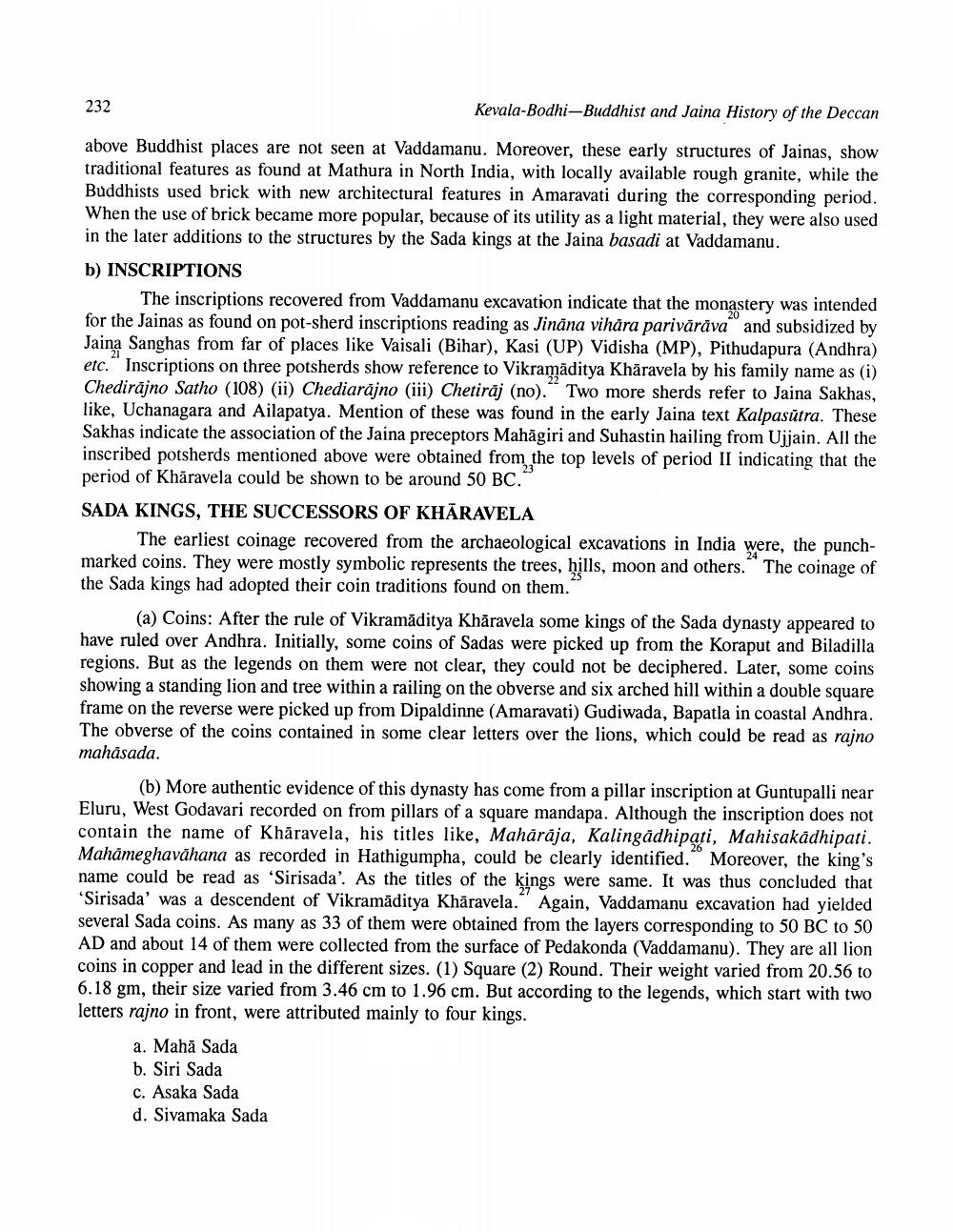________________
232
Kevala-Bodhi-Buddhist and Jaina History of the Deccan
above Buddhist places are not seen at Vaddamanu. Moreover, these early structures of Jainas, show traditional features as found at Mathura in North India, with locally available rough granite, while the Buddhists used brick with new architectural features in Amaravati during the corresponding period. When the use of brick became more popular, because of its utility as a light material, they were also used in the later additions to the structures by the Sada kings at the Jaina basadi at Vaddamanu. b) INSCRIPTIONS
The inscriptions recovered from Vaddamanu excavation indicate that the monastery was intended for the Jainas as found on pot-sherd inscriptions reading as Jināna vihara parivārāva and subsidized by Jaina Sanghas from far of places like Vaisali (Bihar), Kasi (UP) Vidisha (MP), Pithudapura (Andhra) etc. Inscriptions on three potsherds show reference to Vikramāditya Khāravela by his family name as (i) Chedirājno Satho (108) (ii) Chediarăjno (iii) Chetiraj (no). Two more sherds refer to Jaina Sakhas, like, Uchanagara and Ailapatya. Mention of these was found in the early Jaina text Kalpasūtra. These Sakhas indicate the association of the Jaina preceptors Mahăgiri and Suhastin hailing from Ujjain. All the inscribed potsherds mentioned above were obtained from the top levels of period II indicating that the period of Khāravela could be shown to be around 50 BC. SADA KINGS, THE SUCCESSORS OF KHĀRAVELA
The earliest coinage recovered from the archaeological excavations in India were, the punchmarked coins. They were mostly symbolic represents the trees, hills, moon and others. The coinage of the Sada kings had adopted their coin traditions found on them.
(a) Coins: After the rule of Vikramaditya Khāravela some kings of the Sada dynasty appeared to have ruled over Andhra. Initially, some coins of Sadas were picked up from the Koraput and Biladilla regions. But as the legends on them were not clear, they could not be deciphered. Later, some coins showing a standing lion and tree within a railing on the obverse and six arched hill within a double square frame on the reverse were picked up from Dipaldinne (Amaravati) Gudiwada, Bapatla in coastal Andhra. The obverse of the coins contained in some clear letters over the lions, which could be read as rajno mahásada.
(b) More authentic evidence of this dynasty has come from a pillar inscription at Guntupalli near Eluru, West Godavari recorded on from pillars of a square mandapa. Although the inscription does not contain the name of Khāravela, his titles like, Mahārāja, Kalingadhipati, Mahisakadhipati. Mahämeghavāhana as recorded in Hathigumpha, could be clearly identified. Moreover, the king's name could be read as 'Sirisada'. As the titles of the kings were same. It was thus concluded that "Sirisada' was a descendent of Vikramāditya Khāravela. Again, Vaddamanu excavation had yielded several Sada coins. As many as 33 of them were obtained from the layers corresponding to 50 BC to 50 AD and about 14 of them were collected from the surface of Pedakonda (Vaddamanu). They are all lion coins in copper and lead in the different sizes. (1) Square (2) Round. Their weight varied from 20.56 to 6.18 gm, their size varied from 3.46 cm to 1.96 cm. But according to the legends, which start with two letters rajno in front, were attributed mainly to four kings.
a. Mahā Sada b. Siri Sada c. Asaka Sada d. Sivamaka Sada




